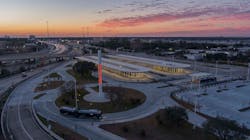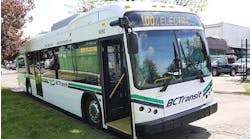Houston METRO Transforms Aging Transit Hub into Flagship Facility
Houston’s Northwest Transit Center is proof that a major transit hub can maintain operations while undergoing a complete renovation and become a modern model of mobility, accessibility and user experience.
“The new Northwest Transit Center provides the best patron experience possible,” said Bruce Krantz, vice president of construction for the Metropolitan Transit Authority of Harris County (Houston METRO). “This is our new gold standard for facilities.”
The 30-year-old transit hub serves as a key connection point for park-and-ride and local bus transfers from two of the region’s largest corridors: Interstate 10 and U.S. 290. As ridership grew, Houston METRO saw a greater need to address parking and congestion issues to improve bus and car traffic flow patterns. The renovations addressed the bus queuing burdens at the 10 existing bus bays and increased patron parking space availability.
The now-completed updates have added more bus bays and clearly delineated vehicle and bus traffic while adding improved connectivity, access, safety and security.
Houston METRO Evaluates 10 Concepts
In 2016, Houston METRO partnered with HNTB Corp. to provide planning, final design services and construction phase support for the $35-million expansion and improvement of the Northwest Transit Center. The federally-funded design-bid-build project included a National Environmental Policy Act phase, after which HNTB began design in spring 2017 and completed it in summer 2018.
“METRO required three design concepts,” said Vince Obregon, HNTB project manager, “but we had so many ideas and variations that we actually presented 10 concepts. The client selected three to develop further. From there, we arrived at the recommended alternative.”
“The recommended alternative included everything we wanted,” said Bridgette Towns, Houston METRO vice president of project management and engineering. “We liked its versatility, its welcoming atmosphere, the user-friendliness and it incorporated all eight of our Universal Accessibility principles.”
Design Incorporates Accessibility Goals
Improving patron access to all services had been a METRO priority for years. To advance that goal, Houston METRO developed and adopted eight principles of Universal Accessibility that exceed the Americans with Disabilities Act requirements.
- Equitability: Everyone, regardless of ability, should be able to use the same environment.
- Flexibility: Services or facilities should accommodate a wide range of uses.
- Simplicity: Unnecessary complexity should be eliminated; the facility should be easy to use and understand.
- Perceptibility: The design should effectively communicate information regardless of the user’s sensory abilities.
- Mobility: Appropriate sizing and spacing should maximize mobility.
- Safety: Elements should be arranged to minimize hazards and provide warnings.
- Suitability: Everyone should be able to use the facility efficiently and comfortably.
- Usability: The environment, accessed by disabled or non-disabled patrons, should offer the same experience in effectiveness, efficiency and satisfaction.
“Universal Accessibility not only includes those who are disabled but those patrons who ride their bicycles or walk to the transit center,” Towns said.
The new Northwest Transit Center would be the first of the agency’s facilities to incorporate all eight principles. A virtual reality model of the facility’s design helped Houston METRO visualize how patrons would interact with the new transit center.
"The virtual tour simulated the transit center access from a walking perspective and from a wheelchair, giving all patrons the experience regardless of their abilities” Obregon said.
“We were very pleased with the final design,” Towns said. “It is well-thought-out and addressed all our needs.”
In addition, Houston METRO collaborated with multiple departments and agencies to improve pedestrian and vehicular circulation throughout the transit center, park-and-ride lot and access and egress roadways.
The final design included two platforms with a total of 20 bays for local commuter buses and a third platform dedicated to Houston METRO’s new Uptown Bus Rapid Transit Silver Line. There is also ample parking, with a new lot designed to hold 195 vehicles, as well as an existing additional parking lot with 256 spaces adjacent to the facility, which the authority currently leases from the Texas Department of Transportation.
Phasing Maintains Operations
Perhaps the most challenging part of the project was determining how to maintain bus service while the existing facility was leveled to virgin soil and rebuilt.
“We did not want to temporarily relocate the facility,” Krantz said. “It would have created too much confusion and pushback from patrons. So, the task was to find a way to keep operations on-site.”
Collaborating with Houston METRO, the HNTB team created a phased interim operations plan that would maintain operations while giving the contractor full access to the project site. Under phase 1, the authority would move all bus services to five bus stops along Old Katy Road, as well as to the existing temporary parking lot just east of the transit center bus canopy. The “temporary transit center” would include a 10-bay bus platform. Under phase 2, with the temporary configuration complete and operating, the contractor could demolish the vacated facility, construct two bus platforms and add new access roadway inclusive of a roundabout. In phase 3, Houston METRO would transfer bus operations from the temporary site to the new facility, freeing up the temporary site destined to become a new, permanent parking lot.
On paper, it worked. But would it be successful in the real world? To test the plan, Houston METRO and HNTB held multiple meetings to confirm the plan’s operational feasibility. They developed geometric configurations and ultimately created a live testbed of the proposed plan to observe actual bus movements at Houston METRO’s Bus Service Center parking lot.
“The interim operation plan was safety-driven and maintained nearly seamless connectivity,” Krantz said.
According to Al Ramirez, superintendent for the contractor, SpawGlass, the phasing facilitated construction.
“The benefit was being able to construct a temporary bus platform, which gave us the opportunity to start on phase 2, the most complicated portion of the project, before phase 1 was completed,” Ramirez said.
Facility is Designed to Expand
Construction started in June 2019, and in December 2020, Houston METRO unveiled a modern, new facility, double the size of the previous center.
Hailed as a first-of-its-kind multimodal center, the new Northwest Transit Center features Universal Accessibility, a full-service Houston METRO RideStore, extensive Intelligent Transportation Communications connectivity to shared-use bike paths, LED lighting and surveillance systems to enhance safety and security.
“Bus traffic and vehicular traffic [updates] for local, park-and-ride and HOV lane access have greatly improved,” Krantz said.
Further, the facility is designed to accommodate Houston METRO’s long-term service goals.
“With METRONext, METRO plans to add 75 miles of BRT lanes to our system, which correlates to many additional BRT buses,” Krantz said.
The new multimodal transit center also could become a BRT connection point from a proposed terminus for a high-speed rail line station between Houston and Dallas.
“The center is designed to handle both current ridership and future capacity,” Towns said.
Center is Accessible to All
Incorporating Houston METRO’s Universal Accessibility principles into the facility’s design resulted in raised walkways across bus travel lanes to increase pedestrian visibility. There are docking stations for recharging wheelchair batteries, handrails, expanded handicap parking and braille signage.
The facility is equipped to accommodate strollers and service animals. There are fully accessible public restrooms, bike storage facilities and a bike repair station. BRT bus platforms offer level access for safer loading and unloading. In the near future, Bluetooth bus bay beacons, accessible on a smartphone app, will help guide patrons to the right bus bay.
According to Towns, the authority’s insistence on the Northwest Transit Center incorporating its Universal Accessibility principles will pay off for years to come.
“The facility works for everyone, regardless of age, mobility, visual, auditory and mental ability,” Towns said. “When a design addresses the needs of every stage of human life, it gives a facility a longer useful life and reduces the need to retrofit later.”
# # #
Jody Summers is a freelance writer who has been serving the transit industry for 15 years. She lives in North Kansas City, Mo.




